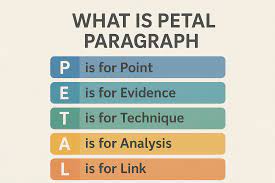
A PETAL paragraph is a structured way of writing that helps students build clear, well-developed responses in essays. The acronym stands for Point, Evidence, Technique, Analysis, Link. Each step provides a logical flow so ideas are communicated effectively.
The first step is the Point. This is your topic sentence and should directly answer the question or present the main idea of the paragraph. It must be concise and assertive, setting up what the rest of the paragraph will explore. For example, in an English essay, a point might be: “Shakespeare presents prejudice as a destructive force.”
The second step is Evidence. This is where you support your point with a direct quotation, example, or reference from the text or subject material. Evidence should be specific and relevant, not vague generalisations. Using a quote demonstrates close engagement with the text.
Next is Technique. Here, you identify the literary, rhetorical, or structural technique used in the evidence. This could be metaphor, imagery, repetition, or irony. Naming the technique shows you understand how the text is constructed, not just what it says.
The Analysis follows, where you explain how the technique supports your point. This is the most detailed part of the paragraph, as it unpacks the deeper meaning, explores the effect on the audience, and links back to the essay question. Strong analysis avoids retelling the plot and instead focuses on interpretation.
Finally, the Link connects your paragraph back to the overall essay question or thesis. It ensures cohesion, showing how the point contributes to the larger argument.
In summary, PETAL paragraphs provide a clear, formulaic structure that strengthens essay writing. By consistently making a point, backing it up with evidence, identifying techniques, analysing their impact, and linking to the thesis, students can write with clarity and persuasiveness.
Michael Fry

